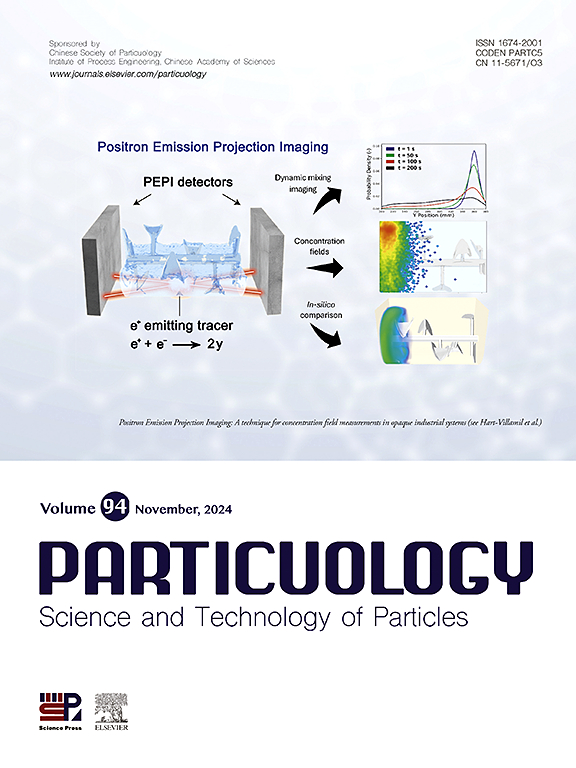喷雾干燥和SDS表面改性制备高纯度氧化铝颗粒去除亚甲基蓝
IF 4.1
2区 材料科学
Q2 ENGINEERING, CHEMICAL
引用次数: 0
摘要
本文采用喷雾干燥法制备了形态均匀、粒度分布均匀的新型高纯氧化铝颗粒。尽管合成的氧化铝具有优异的物理特性,但其与染料的相互作用仍然很低。选用阴离子表面活性剂十二烷基硫酸钠(SDS)对氧化铝表面进行改性,提高了对亚甲基蓝(MB)的去除性能。利用傅里叶变换红外光谱(FT-IR)、x射线衍射(XRD)、zeta电位、扫描电镜(SEM)和氮吸附/脱附等温线对sds改性氧化铝(SA)的吸附性能进行了表征。在工作溶液pH、SDS浓度、物料用量、吸附质浓度、离子强度和温度为60 min时,SA对MB的去除率可达99%左右,反应速率为0.05 g/(mg min)。此外,采用两步吸附模型有效地说明了MB的吸附等温线,计算出的qmax值为60.99 mg/g。该吸附剂对MB、Janus Green B (JGB)和Victoria Blue B (VBB)均有较强的吸附亲和力。FT-IR分析和zeta电位分析证实了MB对SA的去除机理。此外,经过5次循环后,SA的去除率仅下降了近15%,表明吸附剂具有良好的再生性能。这些结果表明,SA是一种很有前途的材料,用于清除含有各种阳离子染料的废水。本文章由计算机程序翻译,如有差异,请以英文原文为准。

Fabrication of high-purity alumina particles by spray drying and surface modification with SDS for methylene blue removal
In the present paper, we facilely fabricated novel high-purity alumina particles with uniform morphology and size distribution by spray drying method. Despite the synthesized alumina's excellent physical characteristics, its interaction with dyes remains low. Sodium dodecyl sulfate (SDS), an anionic surfactant, was chosen to modify the alumina surface for enhanced methylene blue (MB) removal performance. The SDS-modified alumina (SA) adsorbent properties were discovered by utilizing fourier transform infrared spectroscopy (FT-IR), X-ray diffraction (XRD), zeta potential, scanning electron microscope (SEM), and nitrogen adsorption/desorption isotherms. The favorable conditions for MB removal onto SA including working solution pH, SDS concentration, material dosage, adsorbate concentration, strength of ionic, and temperature were set at 60 min. The MB removal efficiency on SA reached approximately 99 % with a corresponding reaction rate of 0.05 g/(mg min). In addition, the MB adsorption isotherm was illustrated effectively using a two-step sorption model, with a calculated qmax value of 60.99 mg/g. The novel adsorbent exhibited strong adsorption affinity for both MB, Janus Green B (JGB), and Victoria Blue B (VBB). The removal mechanism of MB on SA was thoroughly conferred and supported by FT-IR analysis and zeta potential. Furthermore, the removal efficiency of SA only decreased nearly 15 % after 5 cycles, indicating that the adsorbent exhibited respectable regeneration performance. These results demonstrated that SA is a promising material for the scavenge of wastewaters containing various cationic dyes.
求助全文
通过发布文献求助,成功后即可免费获取论文全文。
去求助
来源期刊

Particuology
工程技术-材料科学:综合
CiteScore
6.70
自引率
2.90%
发文量
1730
审稿时长
32 days
期刊介绍:
The word ‘particuology’ was coined to parallel the discipline for the science and technology of particles.
Particuology is an interdisciplinary journal that publishes frontier research articles and critical reviews on the discovery, formulation and engineering of particulate materials, processes and systems. It especially welcomes contributions utilising advanced theoretical, modelling and measurement methods to enable the discovery and creation of new particulate materials, and the manufacturing of functional particulate-based products, such as sensors.
Papers are handled by Thematic Editors who oversee contributions from specific subject fields. These fields are classified into: Particle Synthesis and Modification; Particle Characterization and Measurement; Granular Systems and Bulk Solids Technology; Fluidization and Particle-Fluid Systems; Aerosols; and Applications of Particle Technology.
Key topics concerning the creation and processing of particulates include:
-Modelling and simulation of particle formation, collective behaviour of particles and systems for particle production over a broad spectrum of length scales
-Mining of experimental data for particle synthesis and surface properties to facilitate the creation of new materials and processes
-Particle design and preparation including controlled response and sensing functionalities in formation, delivery systems and biological systems, etc.
-Experimental and computational methods for visualization and analysis of particulate system.
These topics are broadly relevant to the production of materials, pharmaceuticals and food, and to the conversion of energy resources to fuels and protection of the environment.
 求助内容:
求助内容: 应助结果提醒方式:
应助结果提醒方式:


